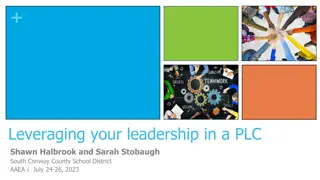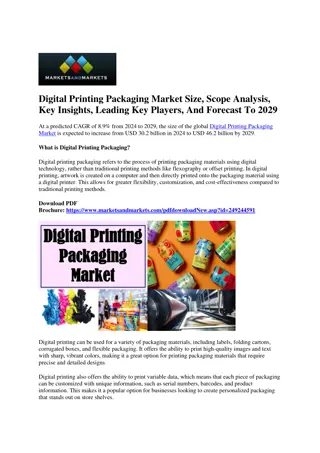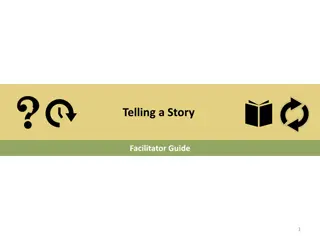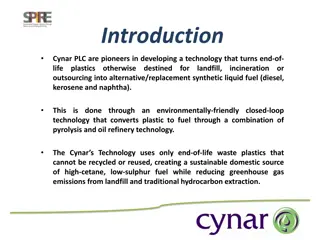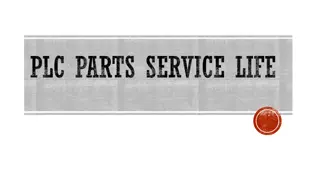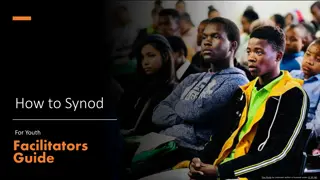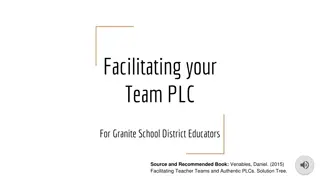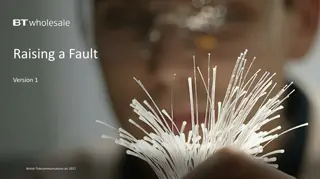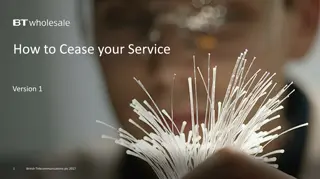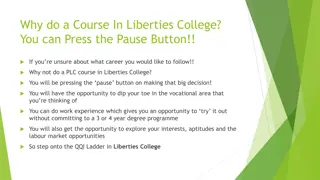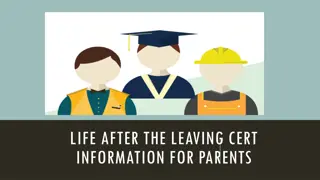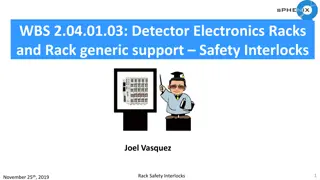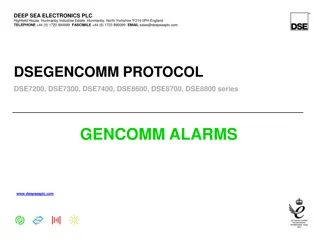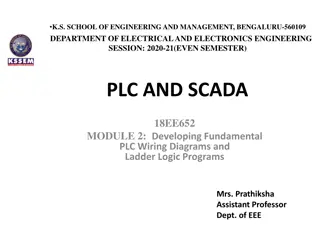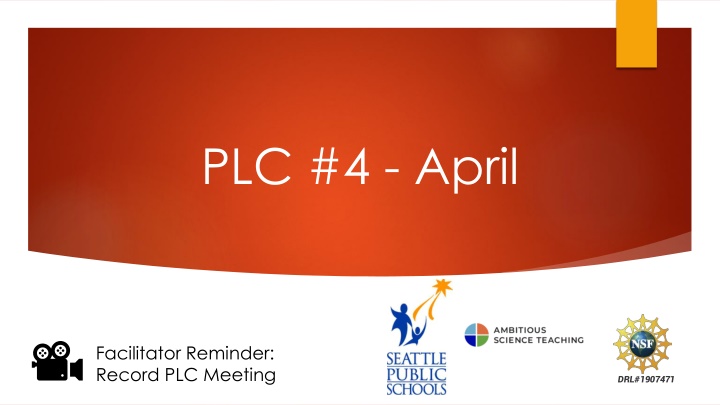
Effective PLC Meeting Agenda for April Facilitator Reminder
Engage in a productive PLC meeting with a structured agenda including opening connections, critical friends consultancy protocol, sharing progress, grounding in norms, and reviewing artifacts. Enhance collaboration and professional development within your group.
Download Presentation

Please find below an Image/Link to download the presentation.
The content on the website is provided AS IS for your information and personal use only. It may not be sold, licensed, or shared on other websites without obtaining consent from the author. If you encounter any issues during the download, it is possible that the publisher has removed the file from their server.
You are allowed to download the files provided on this website for personal or commercial use, subject to the condition that they are used lawfully. All files are the property of their respective owners.
The content on the website is provided AS IS for your information and personal use only. It may not be sold, licensed, or shared on other websites without obtaining consent from the author.
E N D
Presentation Transcript
PLC #4 - April Facilitator Reminder: Record PLC Meeting DRL#1907471
PLC Agenda 1) Opening 20 minutes Connection and Sharing Grounding in Norms & Critical Questions 2) Critical Friends Consultancy Protocol 50 minutes 3) Closing 15 minutes
Connections and Sharing 10 minutes TELL THE STORYLINE/PROGRESSION OF WHAT YOU HAVE DONE SO FAR HOW DID YOU ADDRESS YOUR LINE OF INQUIRY/WHAT STRATEGY DID YOU USE? HOW DID THAT SHIFT/FIT INTO WHAT YOU HAVE BEEN TRYING SO FAR THIS YEAR HOW CAN YOU BUILD ON THIS / MOVE YOUR WORK FURTHER / HOW DID THIS CHANGE YOUR PRACTICE?
Grounding in Norms and Critical Questions Open your team notes from last session Revisit purpose/line of inquiry Revisit norms Add/revise as necessary Review the blue/purple section of the notes guide Which critical equity questions resonate with your group?
Critical Friends Consultancy Protocol Review the protocol so everyone knows what to expect Identify who will be in each role for this session Presenter teacher bringing student work and a question to group to discuss Facilitator (s) a colleague who coordinates the group process and monitors time while participating Participants teacher colleagues who collaborate in the analysis of student work Timekeeper if facilitator wants to share the time keeping part of facilitating Notetaker - (Recommend Curriculum Specialist)
Presenter Overview 5 minutes Presenter gives an overview of the video and the central question or dilemma. Please address the following factors: o Brief context of the lesson(s) & student(s) featured in the video o What central question or dilemma were you trying to address through your routine/strategy you implemented in the video? o What informed your decision to try this strategy/routine? o How does this connect to your group s line of inquiry?
Review Artifacts/Student Ideas 15 minutes The group watches a 5-7 minute video segment with student talk from a relevant lesson. Optional: Group quietly reads and reviews relevant student work pertaining to the presenter s question, attending to students ideas, stories, identities and assets.
Clarifying Questions 5 minutes Participants ask clarifying questions of the presenter. Clarifying questions have brief, factual answers. Presenter responds to the clarifying questions.
Probing Questions 5 minutes Participants ask probing questions of the presenter. Probing questions push the presenter to think deeply about assumptions and different perspectives. The goal is to use questions to help the presenter expand his/her thinking about the student work and the central question. Presenter responds to the probing questions, but there is no larger discussion.
Probing Questions Resource Examples: Why do you think...? What patterns have you noticed ...? What do you think supported/led to [noticing about student thinking]? What would you want to change in order for...? How did you decide/determine/conclude...? What is the connection between... and...? What was your intention when...? How might your students [verb] about...? What's another way you might...?
Consultancy 10 minutes The presenter is a silent listener while participants engage in a larger discussion of the student work, the central question, and the information gathered from the responses to questions. What did you see teacher/students doing that worked toward justice-centered teaching and learning? What worked? Under what conditions? For whom? How did the lesson challenge How is science done? What counts as science? Who gets to do science?
Reflection 10 minutes Presenter reflects on any new ideas, new perspectives, or new questions that emerged from the group discussion. Presenter also reflects on their central question in light of the discussion.
Debrief 10 minutes Facilitator leads a conversation about the overall group process reflecting on the dynamics of the group and the three equity and justice lines of inquiry (Power, Expansive Explanations, & Funds of Knowledge). How did the process work for you today? How did today's discussion help us think about our line of inquiry?
Connection and Sharing What did you try on over the past few weeks with your students? What did you notice or what came up for you? What connections are you making to our lines of inquiry? (Power, Expansive Explanations, & Funds of Knowledge).
Purple Section Questions How am I/are we privileging all voices? How am I thinking about different family conditions? How am I giving opportunities for students' whole lives to become a visible part of the culture upon which meaningful learning is built? How am I positioning the disruption and transformation of guest/host classroom relationships as the responsibility of all members of the learning community? What social issues connect to the quality of life for my students? How am I making space for students to bring those forward? Whose intellectual histories am I privileging? How can my instruction authentically respond to my students' identities? How will each lesson or unit plan help students to know something about their identities or the identities of others? How am I engaging students in understanding how scientific practices and knowledge are always developing? How am I engaging students in understanding how their own community histories, values and practices have contributed to scientific understanding and problem solving and will continue to do so?
PLCs journey to Equity & Justice in K-5 science *How did the lesson challenge how is science done? What counts as science? How am I giving opportunities for students How am I positioning the disruption and transformation of guest/host classroom relationships as the responsibility of all members of the learning community? and practices have contributed to scientific the identities of others? built? knowledge are always developing? What social issues connect to the quality of life for my students? How am I making Who gets to do science? whole lives to become a visible part of the How am I engaging students in understanding how their own community histories, values How will each lesson or unit plan help students to know something about their identities or students' identities? forward? understanding how scientific practices and How can my instruction authentically respond to my am I privileging? culture upon which meaningful learning is Whose intellectual histories space for students to bring those How am I/are we privileging all voices? How am I engaging students in How am I thinking about different family conditions? understanding and problem solving and will continue to do so? September June PLC-3 PLC-4 PLC-2 PLC-1 Achievement, Representation, Identification Justice Opportunity & Access Expanding
Vision Our team is focusing on (expansive explanations, funds of knowledge, power) in science teaching and learning because ____________________.
Closing 15 minutes What will you as a team try next? As individuals? Who will present next month? (May) When will we meet in May?


